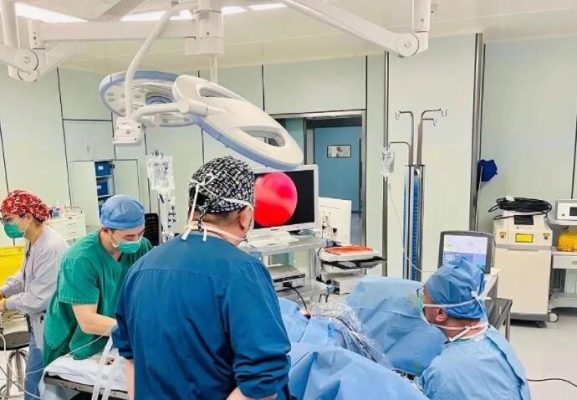Estudio de las propiedades de la película de polieteretercetona (PEEK)
Polyetheretherketone (PEEK) has the properties of high temperature resistance, fatigue resistance, chemical resistance, wear resistance, hydrolysis resistance, as well as excellent mechanical properties, barrier properties, electrical properties, radiation resistance, etc. It has attracted widespread attention from scholars at home and abroad, and in-depth research has been conducted on the properties and modification of the material. It has been used in machinery, petrochemicals, nuclear power, rail transportation, and biomedical materials.
PEEK film is an important form of PEEK besides being used as engineering plastics and fibers. Its domestic application areas are mainly electronic product diaphragms, thermal insulation film layers of aircraft sound insulation blankets, heat-resistant insulation tapes, and flexible printed circuit boards. At present, PEEK film mainly relies on imports, and only a very small number of domestic companies have achieved industrialized production of PEEK film.
This paper prepares a series of PEEK films by extrusion casting. The thickness tolerance of the prepared films is small and the film surface flatness is high. The basic properties, optical properties, mechanical properties and factors affecting the mechanical properties of PEEK films are discussed, and some basic data support is provided. It is hoped that the industrialization of PEEK films in China will be accelerated, and the application scope of PEEK films will be expanded.
Basic properties of PEEK film
PEEK is a semi-crystalline polymer. The light transmittance and physical properties of the film are closely related to the structural morphology of the polymer molecular chain. The PEEK film is opaque brown in a high crystallinity state and transparent light brown in an amorphous to low crystallinity state. The figure below is a photo of the prepared PEEK film.

Photo of PEEK film
The density of PEEK film is 1.26~1.30 g/cm3, the density in amorphous state is 1.26g/cm3, the glass transition temperature of PEEK film is 145℃, the cold crystallization peak temperature is 174℃, and the melting point is 341℃.
The PEEK film with a transmittance of 84.6% and a thickness of 95μm was heated at 250℃ for 20min for heat treatment. The figure below shows the wide-angle XRD spectra of the PEEK film before and after heat treatment. PEEK belongs to the orthorhombic crystal system. The crystallinity of the film before heat treatment is low. After heat treatment, the PEEK film has 4 main diffraction peaks, which appear at 18.7°, 20.6°, 22.6°, and 28.6°, respectively, corresponding to 110, 111, 200, 211, and 202 directions, respectively. The peaks in the 211 and 202 directions overlap. The test data is consistent with the literature reports. Since PEEK is a semi-crystalline polymer, the amorphous region causes a higher diffraction peak background.

Wide-angle XRD spectrum of PEEK film
The figure below is a SEM photo of the cross-sectional structure of a PEEK film. The PEEK film can maintain high toughness in liquid nitrogen. The PEEK film prepared by the extrusion casting method has a casting roll temperature higher than the glass transition temperature of PEEK. Since the casting roll has a certain rotation speed, the film has a certain stretch in the longitudinal direction. From the figure, it can be observed that the longitudinal section of the film has a high degree of orientation of the polymer molecular chain along the stretching direction.

SEM photo of the cross section of PEEK film
Relationship between film crystallinity and transmittance
The temperature and speed of the casting roll directly affect the structure and thickness of the film. The relationship between transmittance and crystallinity is shown in Table 1. When the film thickness is the same, the higher the crystallinity, the lower the transmittance.

Table 1 Relationship between transmittance and crystallinity
The haze of the film can also reflect the color state of the film. The higher the crystallinity, the larger the haze value. When the crystallinity is below 5%, the film is highly transparent and clear.

PEEK film
Analysis of mechanical properties of cast film
Since there is no standard for PEEK film in China, the methods for tensile testing of PEEK film in academic literature are not unified, and the influence of tensile rate on the mechanical properties of film needs to be explored. 18μm PEEK cast film was used for testing, and the tensile rate of the film was tested from 40 to 100 mm/min. The experimental results are shown in Table 2.

Table 2 Relationship between mechanical properties and tensile rate
The tensile strength of the samples showed a common point, that is, the tensile rate had little effect on the tensile strength and elongation at break. Increasing the tensile rate significantly increased the yield strength. When the tensile rate was 100 mm/min, the tensile strength of the film was still high. The mechanical properties of the PEEK film in this paper were tested at a tensile speed of 100 mm/min.

The effect of the casting roll speed on the mechanical properties is shown in Table 3. Under the same extruder temperature and screw speed, different casting roll speeds will lead to changes in film thickness. The higher the casting roll speed, the thinner the film. Therefore, the film has a certain stretch in the longitudinal direction. As the casting roll speed increases, the stretching becomes larger. From the longitudinal tensile strength data, the tensile strength increases with the increase of the casting roll speed, from 129 MPa of the 95μm film to 155 MPa. The elongation at break tends to decrease with the increase of the casting roll speed. Corresponding to the trend, the yield strength increases. From the transverse tensile data, the transverse tensile strength increases with the increase of the casting roll speed, but there is no obvious fixed trend in the elongation at break and the yield strength.
 Table 3 Effects of casting roll speed and extrusion temperature on film mechanical properties
Table 3 Effects of casting roll speed and extrusion temperature on film mechanical properties
The extrusion temperature has an impact on the mechanical properties of the film. Due to the high processing temperature, side reactions such as partial degradation occur during the melt extrusion process. The melting point peak of PEEK is around 340°C. DSC data shows that it is completely melted at 350°C, so it can be processed at a processing temperature above 370°C. By comparing the mechanical properties at extrusion temperatures of 390, 400, and 420°C, the processing stability of the PEEK material is verified. As can be seen from Table 3, the mechanical properties of PEEK are stable at 390~400°C. Even if the temperature reaches 420°C, it can still maintain a high mechanical strength. PEEK has a wide processing temperature, which is conducive to production and processing.
Analysis of Mechanical Properties of Biaxially Stretch Films
PEEK film has a high elongation at break at room temperature, but the tensile strength of cast film is low, and its application in some fields may be limited. The key to controlling the thickness of cast film lies in the die head. The thickness tolerance of the film prepared by the cast method is large, and the biaxial stretching method will reduce the thickness tolerance of the film.
At the same time, the tensile strength of the film can be improved by biaxial stretching. Sample 1# was subjected to biaxial stretching test at 170°C with a stretching rate of 0.3 m/min. When the stretching ratio exceeded longitudinal × transverse = 2.5 × 2.5 times, the film was prone to rupture. Therefore, the stretching ratio was adjusted to longitudinal × transverse = 2 × 2 to study the effect of biaxial stretching on film performance.
The mechanical properties of biaxially stretched film sample 12# were compared with those of sample 3# before stretching and sample 8# of equivalent thickness. It can be seen from Table 4 that biaxial stretching can greatly improve the mechanical properties of the film. The longitudinal tensile strength can reach 203MPa, but the elongation at break is reduced to 76%. The yield strength and elastic modulus of the film are also greatly improved, that is, the film has good rigidity.

Table 4 Mechanical properties of biaxially oriented PEEK films
Analysis of surface defects and thin film mechanical properties
The experiment found that the die head is the key factor restricting the surface quality of the film. Incomplete cleaning of the screw and die head affects the surface of the PEEK film. After the extruder is shut down, it is difficult to clean the screw and die head with the PEEK raw material when it is restarted. There will be more char materials and gel points on the film, which will affect the surface quality and performance of the film. The film was tested after rinsing the PEEK raw material for 2 hours, and samples 10#, 11#, and 13# were obtained, and compared with sample 8#. The results are shown in Table 5. Gel points and char materials affect the surface quality of the film, but a small amount of gel points has little effect on the mechanical properties of the film.

Table 5 Effect of surface defects on the mechanical properties of films
Analysis of UV resistance of thin films
The PEEK film was tested by UV absorption spectrum, and the absorption spectrum could not be obtained because it exceeded the detection range. The UV transmission spectrum is shown in the figure.

UV transmittance spectrum of PEEK film
Figure (a) shows the UV transmission spectrum of a 95μm film in the range of 200~400 nm. It can be seen that the UV transmittance below 380 nm is 0, indicating that the PEEK film has anti-UV properties.
PEEK film has weak UV transmittance at 300nm. Figure 5(b) shows that the UV transmittance of the film with a thickness of 15~21μm is 0.1% at 300nm, while the UV transmittance of the film with a thickness of 95μm is 0.02% at 300nm. As the film thickness increases, the transmittance decreases.
Figure 5(c) shows the UV transmission spectra of PEEK films of different thicknesses in the range of 350-400 nm. Table 6 shows the relationship between the UV transmittance at 380 nm and the film thickness. It can be seen that as the film thickness increases, the transmittance of UV light at 360-380 nm decreases, and the anti-UV performance is better.

Table 6 Relationship between UV transmittance and film thickness
FIG5( d ) is the UV transmission spectra of PEEK films of the same thickness and different crystallinity. As shown in FIG5( d ) and the data in Table 7 , there is a slight difference in the 380 nm UV transmittance. When the crystallinity is high, the anti-UV performance is better.

Table 7 Relationship between UV transmittance and crystallinity
In summary, the conclusions are as follows:
(1) The transmittance of PEEK film decreases with the increase of crystallinity; the stretching rate has little effect on the tensile strength and elongation at break, and the yield strength increases significantly with the increase of the stretching rate; the tensile strength increases with the increase of the casting roll speed; the mechanical properties of PEEK film are stable when extruded at 390~400℃, and even when the extrusion temperature reaches 420℃, the PEEK film can still maintain a high mechanical strength;
(2) Biaxial stretching after casting can greatly improve the tensile strength of PEEK film. The stretching ratio is longitudinal × transverse = 2 × 2. The longitudinal tensile strength can reach 203 MPa and the elongation at break is 76%. The transverse tensile strength is 157 MPa and the elongation at break is 156%.
(3) PEEK film has anti-ultraviolet properties. As the film thickness increases, the crystallinity improves, the transmittance of ultraviolet light at 360~380 nm decreases, and the anti-ultraviolet performance is better.
(Articles and pictures are from the Internet)



